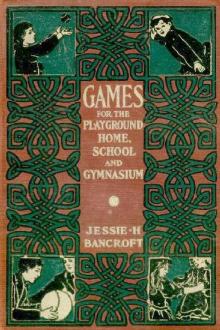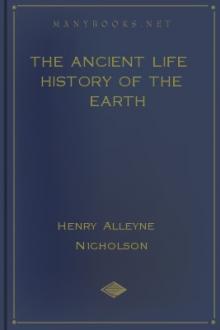Games for the Playground, Home, School and Gymnasium by Jessie Hubbell Bancroft (top novels of all time .txt) 📕

- Author: Jessie Hubbell Bancroft
- Performer: -
Book online «Games for the Playground, Home, School and Gymnasium by Jessie Hubbell Bancroft (top novels of all time .txt) 📕». Author Jessie Hubbell Bancroft
(Add similar movement of the other leg.)
(Add a nodding movement of the head, forward and backward.)
This is a Scotch game and is full of sport, but will depend largely for its success upon the familiarity of the leader with the order of the movements, and, like most Scotch games, upon the rapid and sustained time in which it is kept going. It is especially good for the schoolroom, as it affords some excellent exercise without the players leaving their seats.
KING OF FRANCE (THE)10 to 60 players.
Playground; gymnasium; schoolroom.
Marched up the hill and then marched down again.
The players stand in two rows or groups facing each other. Each group has a leader who stands in the center and represents a king leading his army.
The game or play is a simple one of imitation; in which the players perform in unison some action first indicated by one of the leaders.
The leaders of the two groups take turns in singing the verse, at the same time marching forward during the first line of the verse, and back again to their places during the second line, illustrating the action that is then to be taken by all. The verse is then sung by both groups while advancing toward each other and retreating, performing the movements indicated by the leaders. The movements illustrated by the leaders may be anything suitable to an army of men, the words describing the movement being substituted for the line, "Marched up the hill." Thus:—
Waved his flag and then marched down again.
The following variations are suggested, each of which indicates the movements to go with it.
Beat his drum.
Blew his horn.
Drew his sword.
Aimed his gun.
Fired his gun.
Shouldered arms.
Pranced on his horse.
It is scarcely necessary to say that a real flag and drum add much to the martial spirit of the game, and if each soldier can have a stick or wand over his shoulder for a gun, the esprit de corps will be proportionately enhanced.
KITTY WHITE10 to 30 or more players.
Indoors; out of doors.
This is an admirable game for very little children. Their dramatic tendency should be given full rein in impersonating the soft movements of the kitty and mousie before the chase begins.
To catch the Mousie Gray;
But mousie hears her softly creep;
And quickly runs away.
Run all around the house;
For Kitty White is coming near,
And she will catch the mouse, I fear.
One player is chosen for the mouse and stands in the center, and another for Kitty White, who stands outside of the circle. The other players join hands in a ring and move around, while singing the first four lines. Meanwhile Kitty White is creeping around outside of the circle, peeping in at little Mousie Gray. When the fourth line is reached, "And quickly runs away," the circle stops moving and drops hands while the mouse runs out and in through the circle, chased by Kitty White. For the last four lines, while the chase is going on, the players in the circle stand in place and clap their hands while singing "Run, run," etc.
When the mousie is caught, both return to the circle, and another mouse and kitty are chosen.
4 to 60 players.
Indoors; out of doors.
This is a game for small children. The players join hands and form a ring. They dance around in a circle in time to the music, singing to the air of "Mulberry bush":—
They hang so high they will not come down;
Leave them alone till frosty weather;
Then they will all come down together.
As the last words are sung, the children all stoop suddenly to the ground, to represent the falling nuts. This is more interesting if the time be rapid and if the players jump before stooping, which may lead to their tumbling over as the nuts do when they fall from the trees.
LET THE FEET GO TRAMP10 to 60 players.
Playground; gymnasium; schoolroom.
Let the hands go clap! clap! clap!
Let the finger beckon thee.
Come, dear friend, and skip with me.
La, la la la, la la la, etc.
The players form a circle with from one to five in the center, according to the number of players. All of the players, both circle and center, sing the verse, suiting the action to the words with stamping of the feet for "Tramp, tramp, tramp!" and clapping of the hands for "Clap, clap, clap!" As the last line, "Come dear friend and skip with me," is sung, each child in the center beckons to one in the circle, who steps in and joins hands with the little partner as they stand facing each other. These partners in the center then dance around in time to the chorus "La, la," and the circle players may also join hands and dance in a circle.
LONDON BRIDGE6 to 30 or more players.
Indoors; out of doors.
Falling down, falling down.
London Bridge is falling down,
My fair lady!
Iron bars, iron bars.
Build it up with iron bars,
My fair lady!
Bend and break, bend and break,
Iron bars will bend and break,
My fair lady!
Two of the tallest players represent a bridge by facing each other, clasping hands, and holding them high for the others to pass under. The other players, in a long line, holding each other by the hand or dress, pass under the arch while the verses are sung alternately by the players representing the bridge and those passing under, those forming the arch singing the first and alternate verses and the last "Off to prison." As the words,—
are sung, the players representing the bridge drop their arms around the one who happens to be passing under at the time. The succeeding verses are then sung to "Off to prison he must go." During this last one the prisoner is led off to one side to a place supposed to be a prison, and is there asked in a whisper or low voice to choose between two valuable objects, represented by the two bridge players who have previously agreed which each shall represent, such as a "diamond necklace" or a "gold piano." The prisoner belongs to the side which he thus chooses. When all have been caught, the prisoners line up behind their respective leaders (who have up to this time been the holders of the bridge), clasp each other around the waist, and a tug of war takes place, the side winning which succeeds in pulling its opponent across a given line.
Where a large number of players are taking part, say over ten, the action may be made much more rapid and interesting by forming several spans or arches to the bridge instead of only one, and by having the players run instead of walk under. There is thus much more activity for each player, and the prisoners are all caught much sooner.
This is a very ancient game, supposed to have originated in the custom of making a foundation sacrifice at the building of a bridge. The tug of war is thought by Mr. Newell possibly to signify a contest between powers of good and evil for the soul of the victim sacrificed.
LOOBY LOO5 to 60 or more players.
Indoors; out of doors.
Here we dance, looby, looby, light.
Here we dance, looby, looby, looby, loo,
Every Saturday night.
Put your right hand out
Give your right hand a shake, shake, shake,
Hinkumbooby round-about.
Put your right foot in, etc.
Put your left foot in, etc.
Put your two feet in, etc.
Put your right elbow in, etc.
Put your left elbow in, etc.
Put your two elbows in, etc.
Put your right ear in, etc.
Put your left ear in, etc.
Put your head way in (bend deeply from the waist).
The players stand in a ring, clasping hands. For the first two lines of the chorus,—
Here we dance, looby, looby, light,
the players sway from one foot to the other, throwing the free foot across the other in sort of a balance movement in rhythm to the music. On the last two lines of this verse,—
Every Saturday night,
the circle gallops halfway around to the left for the first line, and reverses the action, returning to place on the last line.
For the alternate verses which describe action the movements are suited to the words; for instance, when the left hand is called for, the players lean far forward and stretch the left hand into the ring while singing the first line, turn around, and stretch the left hand outward for the second line, shake the hand hard on the third line, and on the last line jump or spin completely around.
This is a very ancient game, supposed to have originated in a choral dance, probably in celebration of the rites of some deity, in which animal postures were assumed or animal rites were an object. Later, it was an old court dance, stately and decorous as the minuet.
MUFFIN MAN6 to 30 or more players.
Indoors; out of doors.
The players stand in a circle, with one or more in the center.





Comments (0)